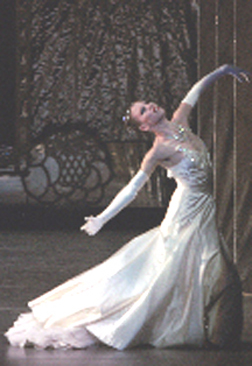Her Way
Kyra Nichols’ Farewell
"Serenade," “Robert Schumann’s ‘Davidsbündlertänze'”, and 'Der Rosenkvalier' from "Vienna Waltzes"
New York City Ballet
New York State Theater,
New York, NY
June 22, 2007
by Mary Cargill
copyright © 2007 by Mary Cargill
 Ballet dancers tend to live in people’s memories through the roles they create, the roles that are permanently linked to their careers. A dancer like Carlotta Grisi lives whenever "Giselle" is performed, and dancers whose lives intersect with great choreographers tend to survive in people’s memories the longest, dancers like Margot Fonteyn, or Patricia MacBride, or Suzanne Farrell. Kyra Nichols, though, has spent her dancing years in other dancers’ parts, most notably in the Farrell roles, which she has managed, through an impeccable technique, wonderful musicality, and sympathetic imagination, to make uniquely her own. The company, and her audience, bade goodbye to her in a program of ballets that she chose. I don’t know if it was a conscious decision, but each ballet was about saying farewell, leaving the cheering audience both sad and grateful to have had so many years.
Ballet dancers tend to live in people’s memories through the roles they create, the roles that are permanently linked to their careers. A dancer like Carlotta Grisi lives whenever "Giselle" is performed, and dancers whose lives intersect with great choreographers tend to survive in people’s memories the longest, dancers like Margot Fonteyn, or Patricia MacBride, or Suzanne Farrell. Kyra Nichols, though, has spent her dancing years in other dancers’ parts, most notably in the Farrell roles, which she has managed, through an impeccable technique, wonderful musicality, and sympathetic imagination, to make uniquely her own. The company, and her audience, bade goodbye to her in a program of ballets that she chose. I don’t know if it was a conscious decision, but each ballet was about saying farewell, leaving the cheering audience both sad and grateful to have had so many years.
"Serenade" also included Ashley Bouder in the Russian dance and Sara Mearns as the Dark Angel. Bouder was incisive and expansive, and Mearns is a particularly luscious dancer. Both have the ability to look beyond the stage, into the music as it were. But this performance was really all about Nichols, who gave the waltz, with an eloquently restrained Philip Neal, a glowing lyricism, without nostalgic or tragic overtones.
"Davidsbündlertänze" does have its tragedy, and its ending, with Nichols silhouetted in resigned grief as Schumann (Charles Askegard) retreats into madness, was particularly wrenching, but there is so much profound beauty in this ballet that it almost beyond tears. It too, got fine performances from its cast; Jenifer Ringer and Jennie Somogyi in particular were able, like Nichols, to create feelings beyond words from movement, and Askegard, in his difficult role (which would be so easy to turn into a caricature of a Mad, Mad I Say, artist), danced with a tragic dignity.
The final scene in "Vienna Waltzes" seems tailor made for farewell performances, with its solitary figure dancing in the haunted ballroom, but Nichols again turned it into what seemed to be her own story, dancing with her invisible partners not with regret or sorrow, but with happy memories of a completed life. This contentment seemed to be her last gift to her audience. I suspect that many, like me, were remembering specific, wonderful performances, which illuminated the roles with her unique glow; Nichols in "Diamonds," turning so slowly with such perfect musicality that mere technique didn’t seem to matter; or the hushed prayer of "Mozartiana;" the moments in "Chaconne" which seemed like overhearing a conversation on Parnassus; the glorious jumps in "Square Dance;" the radiant generosity of her Lilac Fairy, banishing darkness; and especially the doomed woman in "Liebeslieder," dancing beyond the grave. Remember and be glad, she seemed to be saying in that final dance.
Photo: Kyra Nichols in the final scene of "Vienna Waltzes." Photo by Paul Kolnik.
Volume 5, No. 25
June 25, 2007
copyright ©2007 by Mary Cargill
www.danceviewtimes.com